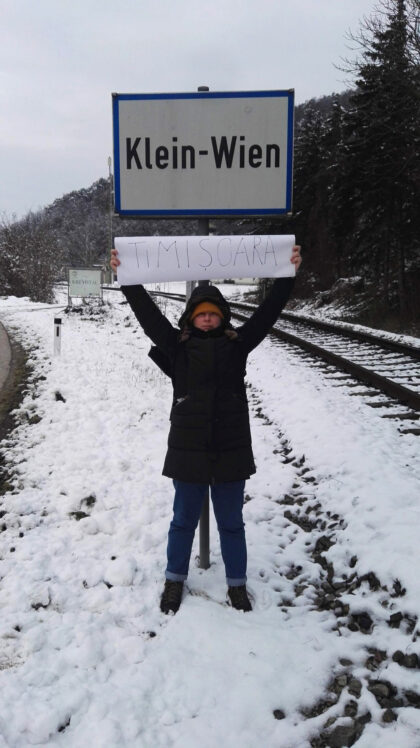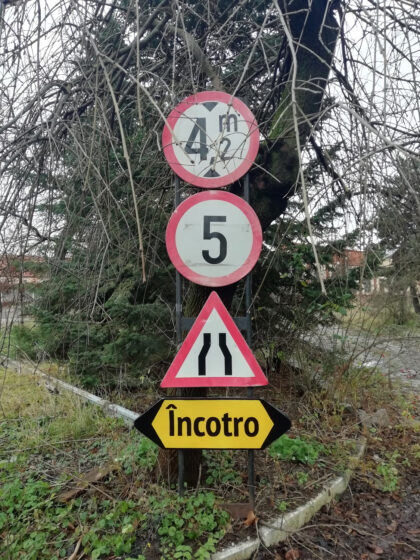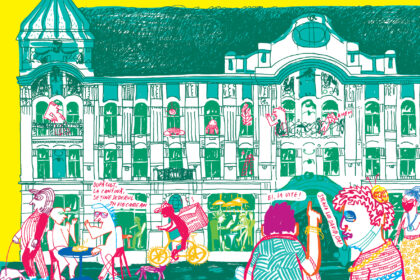Information age produces realistic fiction / Era informațională produce ficțiune realistă, installation (textile work and pencil drawings on wall), 350 x 650 x 2 cm (uninstalled), 2021
in collaboration with Gina Larion, Diana Bobar and Ionela Stratan
commissioned for the group show I feel something, don’t know what, Czuję coś, nie wiem co, Simt ceva – nu știu exact ce
Curators: Magda Kardasz & Diana Marincu
Exhibition dates: 15 April – 5 June 2021, Art Encounters Foundation Timisoara RO and 2 July – 12 September, Miejsce Projektów Zachęty/Zachęta Project Room Warsaw PL

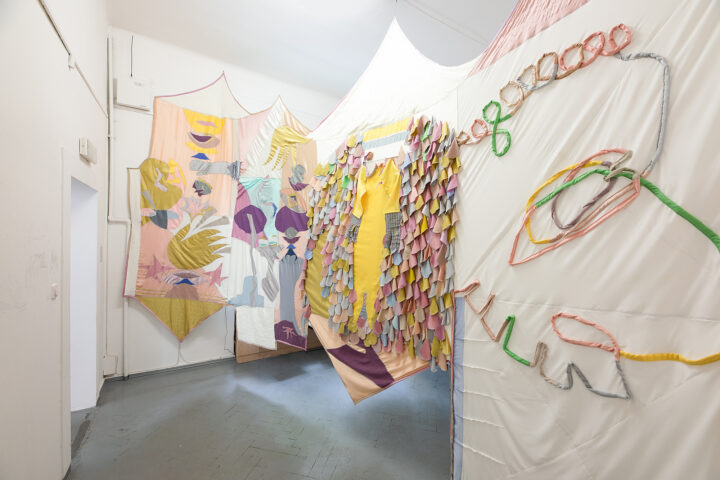
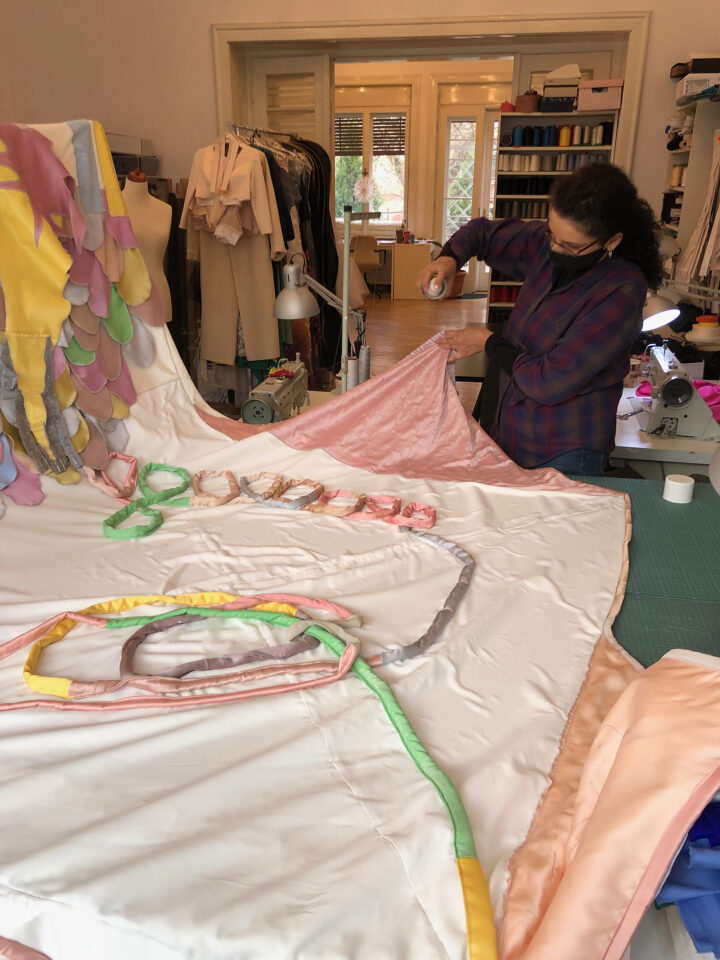
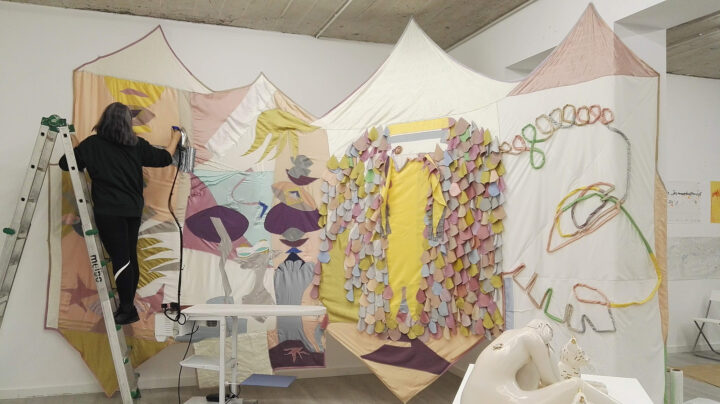
I’ve made a work that’s large but not monumental, using fabric to draw, and thread to write.
The temporal dimension was set at the beginning with my collaborators: the funding can cover approximately 80 to 100 hours in the workshop. This determined the physical dimensions. The work is produced together with 3 professionals working in the local fashion industry, using only discarded materials. One can wear this work, take cover under it, take a nap on it, take pride in it, gaze at it, this work addresses you. It can take various forms, as a skin covering a shelter, as a forest elevator catching leaves and trash, as a flag signaling various identities, as a daybed for a work break. It has as many subjects as it has shapes, all connecting: the old and new age of information, the man-made nature of the many and the private nature of the few, this work is a stream of consciousness sewn in irregular panels.
If a narrative can be about more than just one thing, so can a visual work. We’ve been experimenting and expanding various ideas into fabric until we’ve hit the 40 hours mark and then we’ve focused on the structural integrity and finishing the work. While developing this, we had a number of conversations about the labor of recycling and recuperating fabric, but also about the life of an art work. Is this a work of fast art that would add to the growing trash the way fast fashion does? What’s the purpose of an artwork when it’s not on display? Why work without sketches? And so on. These conversations influenced the general tone of the work, but also technical decisions.
With this work, you’ll have to imagine you are reading fragments from a fiction based on a real place, a lonely hill, Șumiga, about 20 km from the Romanian-Serbian border, on the Romanian side. The last Romanian hill from where you can see the first Serbian hill, at Vršac. In the ‘50s, the escalating tensions at the border lent to the construction of several observational bunkers on all the sides of the hill. Who was surveilling Tito’s activities at the border, how efficient and melancholic were they while stuck in a concrete tomb on a hill? Did they think of Tito as symbolizing the Yugoslavian people, were they thinking of their own eyes as representing the far away will of Ceausescu? Or were they looking for their neighbors’ family, stuck on the other side of a border. The gaze wanders on the surrounding fields and their curated nature – time loses its meaning. Looking for Tito becomes more like Waiting for Godot.
This is a map of a desire: to gaze while not being seen. It’s also a skin to a space, a work of many ideas, shapeshifting in a fixed time frame. Behind it, a series of proposals for installing the work outside the gallery.

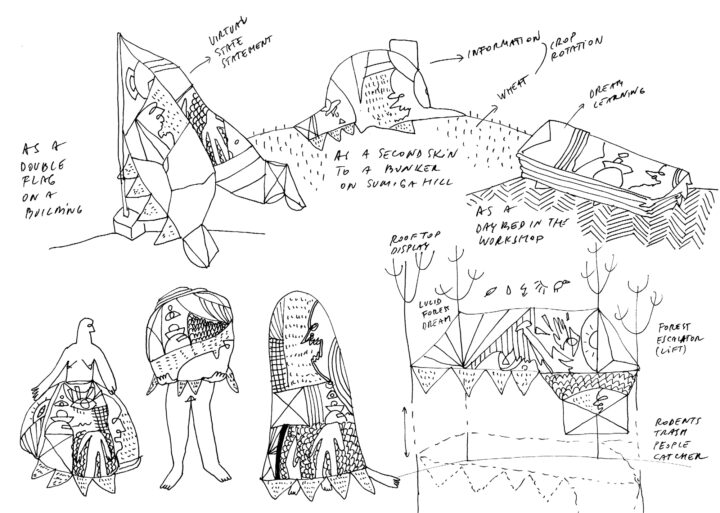
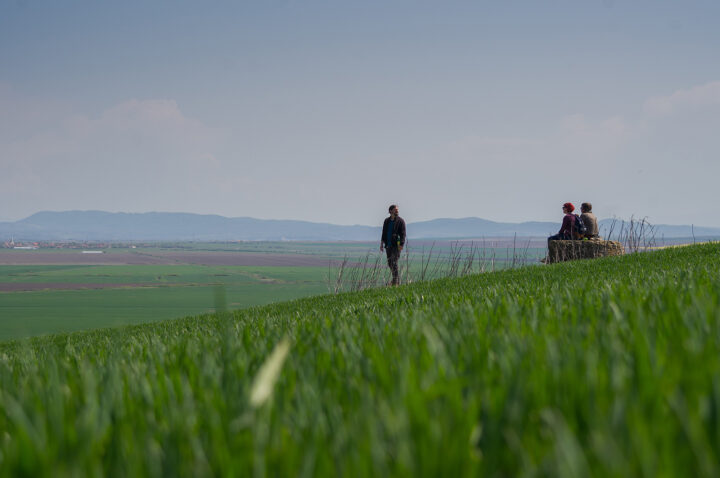
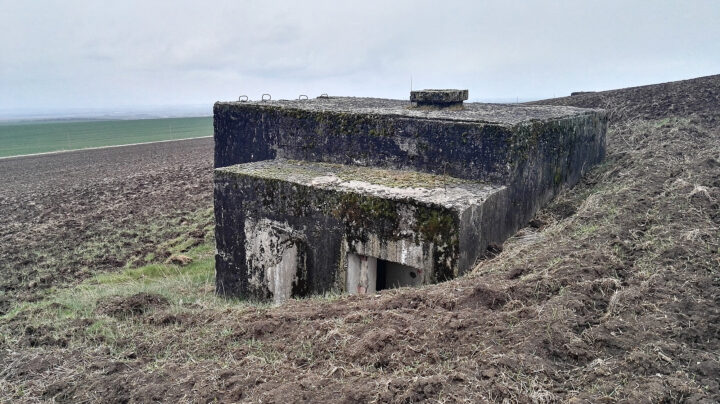
I see you, Tito, from my little bunker on my little hill, I see my neighbour’s family stuck on the other side of the border, the non-aligned one that looks so opulent on TV, I see Vršac’s kula, like a beautiful nipple.
Is this the never-ending informational age where I’m a hunter-gatherer of data, is this my future, hiding in the field of wheat, a bunker’s slit looking at another?
Do you see me, Tito, in my House of Flowers, do you see me counting the ladybugs in the summer, and the rotting files in the autumn, and the foxes in spring?
It’s you and me, Tito, and between us are fields of man-made nature, and concrete cysts.
Surround me with the private nature of the public person, everything just right, no decay please, no rebirth, just the frozen youth that doesn’t match my own.
Be the net on the forest floor that will catch the people’s trash, the dying leaves, and the industrious rodents and bugs. Be the forest rooftop that will catch the lucid dreams, the sun’s radiation and the dancing plastic bags.
I’m gazing at you, analyzing you, interpreting you, you are what I say you are, for I am everywhere and you are here.
Information age produces realistic fiction
It’s man made nature right
Discrete & flat monument
House Star
Star Light
Vivat Sumiga
I see you Tito
Wheat and information (embroidered texts)
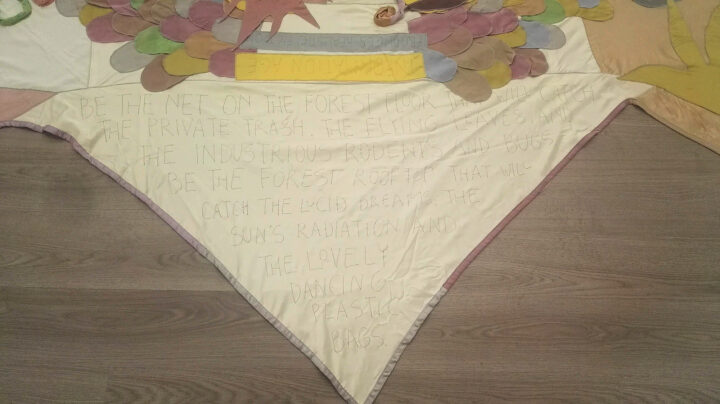
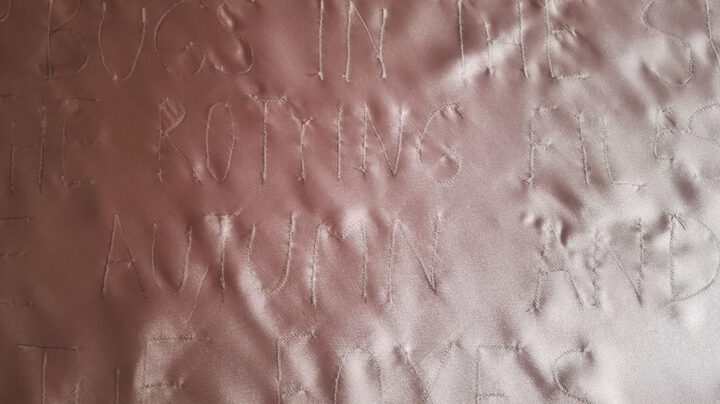
In her art, Ana Kun often refers to history, ecology and analysis of social problems. The artist sometimes works on the borderline between fine arts and activism, as well as in the urban space.
The installation, prepared for the I feel something. Don’t know what exhibition, grew out of the sense of loss, loneliness, uncertainty and captivity which we all share, brought on by the global pandemic that has been ongoing for over a year. The title of the exhibition itself describes a similar state of mind. The artist also seems to be reflecting on present times, in which information technology filters human relationships and pandemic bans distance us from nature and do restrict us from travelling, which further intensifies the isolation.
Another source of inspiration for Ana Kun was her trips to the dormant volcano Sumiga, near Timișoara. It lies just at the border of Romania and the former Yugoslavia (today Serbia), among fields being cultivated on an industrial scale. By the order of Ceaușescu, bunkers were placed on the hill to survey the neighbouring country. The bunker, used for observation, mimics the shape of the natural post-volcanic hill.
Standing in opposition to the concrete hardness and oppressive nature of the bunker, the artist creates large-scale textile, using pieces of soft fabrics in delicate, pastel shades. She proposes several solutions to install the work, depending on the environment (the gallery, the workshop, the forest and the hill). She says, ‘As such, the work may take the shape of a flag, a day bed, a tent or a bunker covering’.
Ana Kun often prepares her projects in collaboration with other creators. This time, they were designers and seamstresses from a local fashion studio. The artist combines scraps of fabrics into colourful collage images, some of which are filled with embroidered texts. Among them is a poem dedicated to a hypothetical soldier sitting in a bunker lost in nature, hopelessly staring at the empty horizon — the author’s personal commentary on the Ceaușescu state oppressively surveilling its citizens. Other texts refer to contemporary forms of social surveillance, including self-censorship – for example, of one’s image in social media.
The artist’s ecological engagement is this time visible in the purposeful use of fabric scraps to create a large-scale collage. Kun’s installation is soft and flexible — it can fit into varied exhibition spaces and adapt to neighbouring another artist’s work. Kun seems to be hinting that perhaps a softer stance/strategy could be a remedy for today’s oppressive reality. It is also the story of the painting’s transition into the third dimension. (curatorial text by Magdalena Kardasz)
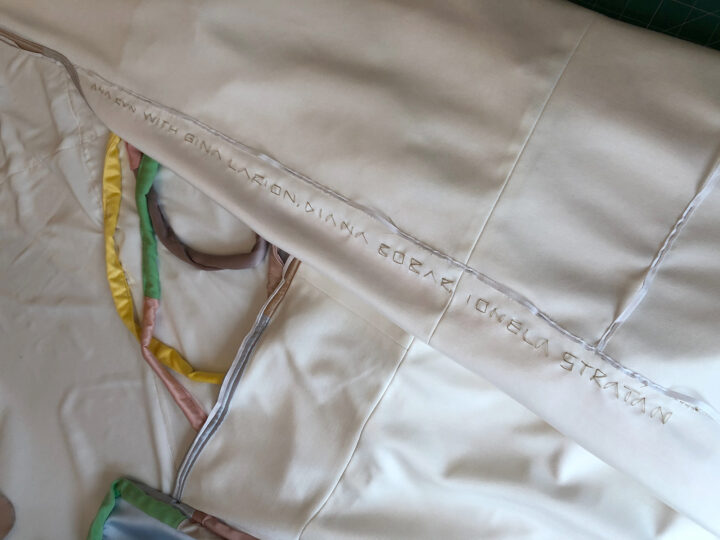
In the work by Kun, prepared in cooperation with designers and seamstresses from a local fashion studio, you can also see the artist’s ecological engagement – she used fabric scraps to create a large-scale collage.
Kun’s installation is soft and flexible – it can fit into varied exhibition spaces and adapt to neighbouring another artist’s work.
Kun seems to be hinting that perhaps a softer stance/strategy could be a remedy for today’s oppressive reality. It is also the story of the painting’s transition into the third dimension.
Another source of inspiration for Ana Kun was her trips to the dormant volcano Șumiga, near Timișoara. It lies just at the border of Romania and the former Yugoslavia (today Serbia), among fields being cultivated on an industrial scale. By the order of the communist regime, bunkers were placed on the hill to survey the neighbouring country. The bunker, used for observation, mimics the shape of the natural post-volcanic hill.
The work may take the shape of a flag, a tent or a shawl. The artist writes on it texts referring to contemporary forms of social surveillance, including self-censorship — for example, of one’s image in social media. The work was created in cooperation with designers and seamstresses from a local fashion studio.
Ana Kun sometimes works on the borderline between fine arts and activism, as well as in the urban space. The artist often refers to history, ecology and analysis of social problems.
In the installation, prepared for the exhibition ‘I feel something, don’t know what / Simt ceva – nu știu exact ce’, she refers to the sense of loss, loneliness, uncertainty and captivity, brought on by the global pandemic that has been ongoing for over a year.
The artist also seems to be reflecting on present times, in which information technology filters human relationships and pandemic bans distance us from nature and do restrict us from travelling, which further intensifies the isolation. (curatorial text for the exhibition in Miejsce Projektów Zachęty/Zachęta Project Room)
